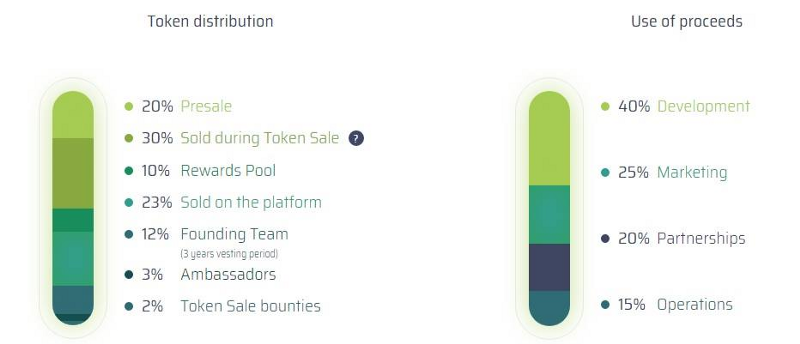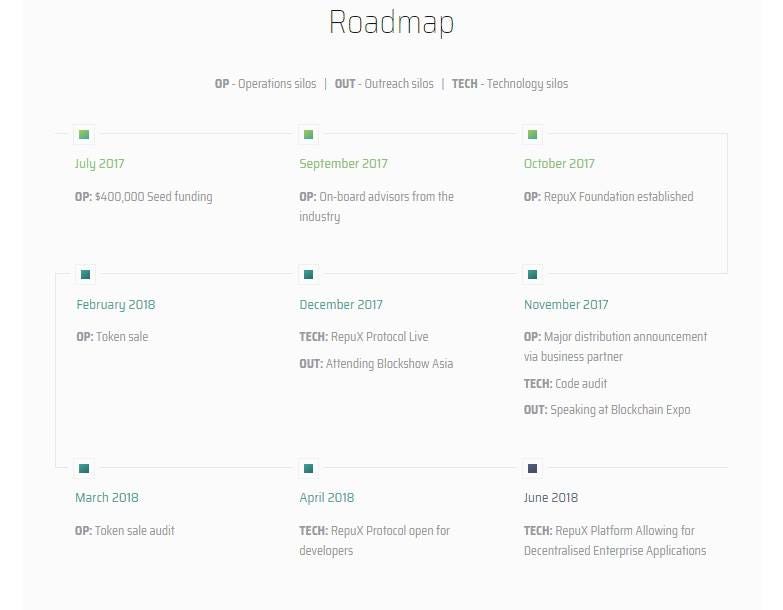REPUX-
Repux is a new crypto project that aims to create a global market for data, using its own network utility token called Repux. The project combines a rapidly growing crypto economy with an explosive data economy in the future. The data market will become more common as time goes on, as data is very important for many of the algorithms that drive the world today, from Google to Facebook, but also from the supply chain to city planning. Repux aims to build a marketplace data platform that will facilitate the trading of this data in a free global market.
The Repux token is part of a larger emerging trend that we see in the crypto ecosystem. Teams with prior business experience try to incorporate the technology behind crypto / blockchain and tokenization, and apply them to future technologies. However, blockchains will unleash their true potential in combination with other technologies, from hi energy to autonomous vehicles.
With the Repux project, the team has an IT background, technology, and large data. This helps them build a reliable network that can attract real players to the market.
Market Needs
Promising and successful projects in the 'token app' space benefit from the tailwinds industry. So let's explore some of the needs and market growth for this niche.
The Economist recently wrote about how the world's most valuable resource is data, not oil. If the thesis is true, then the data and economic data will have a big impact on the future of this world and how humans live and interact with each other. Think about how much of the oil-power economy we had during the twentieth century in our world. Now think of global and digital assets like data that can have even greater impact. Empires will be on the new data economy as we jump into the 21st century, and the full implications of the economy are now beginning to become apparent to everyone.
Think about why it's so hard to compete with people like Facebook and Google. They have very valuable data so that we all contribute unnoticed and without getting a share of the cake. This makes them an effective monopoly of their domain. Together, only these two companies are worth more than a trillion dollars. That's the power of data.
Repo Ecosystem for AI / ML
One of the major markets designed by Repux is the domain of Artificial Intelligence (AI) and Machine Learning (ML). This is a combination of emerging technologies that will complement and feed each other. Creating an AI / ML model requires a large amount of data and validation. Therefore, the data is an entity that is entirely digital but invaluable to everyone from beginners to Silicon Valley to tech giants.
There is no dominant market leader to buy and sell data. Some trends in the blocking room, however, may help some of the issues surrounding validation, throughput, and trust in most. If there is a centralized market, there is not enough transparency for big players. With a decentralized market, players can trade without having to trust an intermediary.
Technology
The Repux platform will take advantage of existing decentralized data storage providers such as IPFS, Sia, and Storj, thus helping the entire crypto ecosystem by using existing technologies. The team will build the API into the system, which will assist in the creation of various applications over the underlying protocol. This allows third-party teams and developers to quickly build applications that utilize the underlying technology.
RepuX Technology
Overview
The technology of the RepuX Protocol can be broken down into 4 separate layers.
FIGURE 2: BREAKDOWN OF THE REPUX PROTOCOL
The application layer is at the top of the RepuX Protocol. This front-facing layer consists of various decentralized applications, or Dapps, that third-party application developers can build on top of the existing RepuX API infrastructure. An example of this could be a service that allows individuals or entities to sell social media usage data in exchange for accessing a website.
The next layer of the RepuX Protocol is the data layer. This layer contains all of the data that can be purchased and sold within RepuX. By storing the data layer in a decentralized infrastructure such as IPFS, StorJ8 or Sia, we do not only ensure the existence of the data, but also ensure that the data is stored in a decentralized fashion. Data ownership, sharing, security and privacy preferences can be actualized using multi-signature cryptographic primitives native to the blockchain, to ensure data be redundantly secured on chain and also seen and utilized by by parties.
In order to handle transactions occurring on the data layer, we employ a decentralized logic layer. This layer could be built on top of the existing Ethereum infrastructure; however, we are also exploring the use of EOS, or a custom blockchain infrastructure that could potentially scale to millions of transactions.
At the base of the RepuX Protocol, we build a value layer, which powers the layers above and ensures that it is compensated appropriately for what they do within the RepuX Protocol. We have created the RepuX Token as part of this value layer to allow parties to send value payments between one another for purchases and sales of data and other goods and / or services. Value of the tokens can be proportional to their demand for use in data sharing contractual services, whereby different tiers of token holding quantities can enable more advanced and larger scale data sharing capabilities. This acts as a mechanism for fairly distributing available blockchain-based data storage and serves as a demand vehicle for tokens that enables fair data usage.
Application Layers and APIs
Blockchain leverages a peer-to-peer network to govern transactions and interactions across a distributed community, making it extremely difficult to create a fraudulent transaction. With blockchain and decentralization, every entity is incorporated in the process and no one entity has control over all of the process.
We designed RepuX, from the beginning, to create an application programming interface (or API) where any application developer can work on the RepuX Protocol. This malleable protocol means that RepuX is not designed for one specific purpose, but rather to permit developers to build upon it for the potential benefit of many different industries.
API Structure
We intend to use easy-to-use Web3.js + Metamask APIs that will allow third parties to easily access and rapidly build external applications upon the RepuX infrastructure. In addition to easy-to-use JS APIs, we can also enable more application-based APIs that third parties can use to develop upon.
Data Layer
In order to ensure user data is stored in a decentralized fashion, we will use a number of different technologies. In this White Paper, we describe an IPFS1 based infrastructure utilizing IPFS hashes. With the RepuX Protocol, we use IPFS in order to maintain the database of data referenced by hashes in our logic layer and APIs. By using IPFS, we do not only guarantee the decentralized nature of our data but also ensure that the data is permanent through IPFS hashes.
What is IPFS?
InterPlanetary File System (or IPFS) is a protocol designed to create a permanent and decentralized method of storing and sharing files. It is a content-addressable, peer-to-peer hypermedia distribution protocol. Nodes in the IPFS network form a distributed file system. IPFS List of contents by a unique "hash". IPFS enables the creation of fully decentralized technologies that can connect all computing devices within the same fiile system. IPFS is similar to how a bit torrent swarm exchanges information, in a decentralized yet organized way.
Key Features of IPFS
IPFS has the following features:
- It defines a content-addressing file system;
- It coordinates content delivery;
- It has file systems and mounting;
- It can be accessed through common protocols such as HTTP;
- It guarantees integrity through the hash-addressed content system;
- Connection can occur through many network protocols;
- There is no central point of failure; and
- It enables additional functionality through systems such as Filecoin.
However, as the infrastructure is still maturing at a rapid pace, we will continue to explore additional data on infrastructure options, such as Storj and Sia.
Presale
November 17, 2017 / 2pm UTC to January 23, 2018 / 2pm UTC

Token Sale
will run for a period of 31 days from 6 February 2018 to 9 March 2018. The round will continue until the 33.1 million USD limit is hit or the final round is over. During REPUX Token Sale can be purchased with ETH, BTC or Wire Transfer rewards, with a minimum contribution of 100 USD (or equivalent to 100 USD in BTC or ETH). During Pre-Sale, the minimum contribution is 30,000 USD.
Standard Token:
Supply of Token ERC20: 500.000.000 REPUX
Token Sale Price: 0.20 US Dollar for 1 REPUX.
Token sales ends on March 9, 2018
Start date: February 6, 2018 / 5pm UTC
End date: 9 Mar 2018 / 5pm UTC
Hard cap: 33.1 million USD
Soft seal: 1,000,000 USD
Payment receives ETH, BTC, XBT and USD via Wire transfer
Supported wallets for Token Sales include MyEtherWallet, Mist-Ethereum Wallet, Metamask, Parity, imToken, Ledger, Trezor, and others.
Roadmap
For More Information Please Click Link Below:
- WEBSITE: https://repux.io/
- ANNOUNCEMENT THREAD: https://bitcointalk.org/index.php?topic=2613666.new
- WHITEPAPER: https://repux.io/white-paper.html
- TWITTER: https://twitter.com/repu_x
- FACEBOOK: https://www.facebook.com/RepuX-415260768888793/
- TELEGRAM: https://t.me/repuxicoEN
- REDDIT: https://www.reddit.com/r/RepuX/
- BLOG: https://blog.repux.io/
Profil Bitcointalk(Nanknink boy): https://bitcointalk.org/index.php?action=profile;u=1711766


Komentar
Posting Komentar